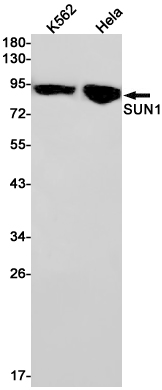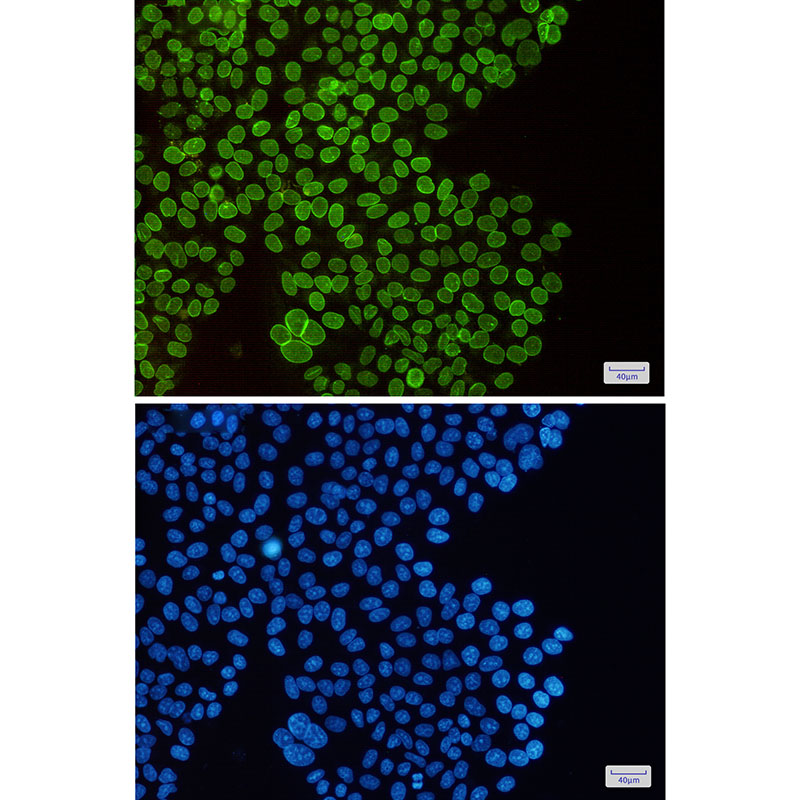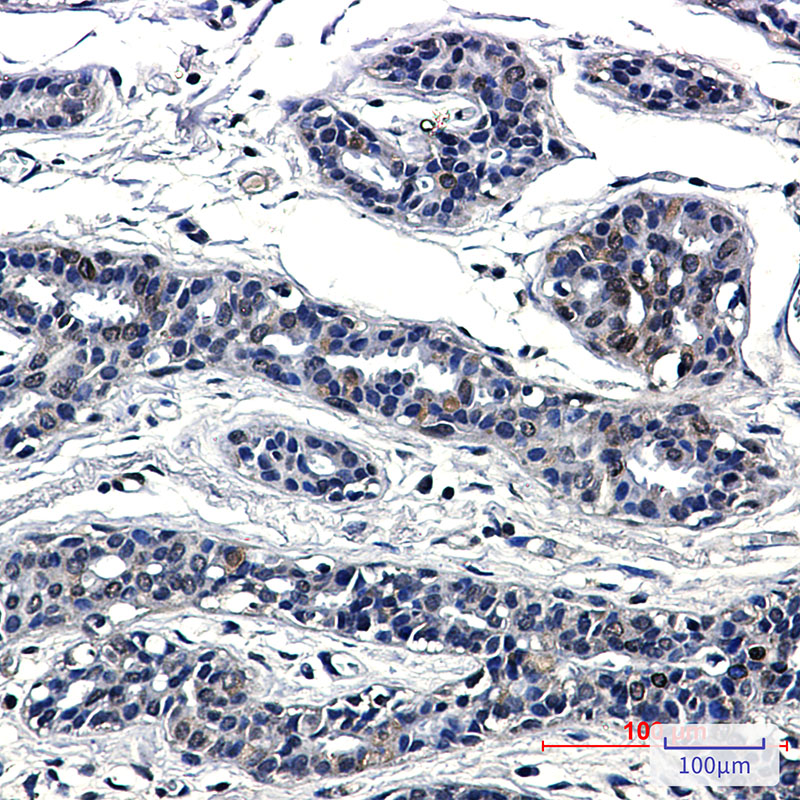


| WB | 1/500-1/1000 | Human,Mouse,Rat |
| IF | 咨询技术 | Human,Mouse,Rat |
| IHC | 1/50-1/100 | Human,Mouse,Rat |
| ICC | 1/50-1/200 | Human,Mouse,Rat |
| FCM | 咨询技术 | Human,Mouse,Rat |
| Elisa | 咨询技术 | Human,Mouse,Rat |
| Aliases | Sun1; UNC84A |
| Entrez GeneID | 23353 |
| WB Predicted band size | Calculated MW: 87 kDa; Observed MW: 90 kDa |
| Host/Isotype | Rabbit IgG |
| Antibody Type | Primary antibody |
| Storage | Store at 4°C short term. Aliquot and store at -20°C long term. Avoid freeze/thaw cycles. |
| Species Reactivity | Human |
| Immunogen | A synthetic peptide of human SUN1 |
| Formulation | Purified antibody in TBS with 0.05% sodium azide,0.05%BSA and 50% glycerol. |
+ +
以下是3-4条关于SUN1抗体的参考文献及其简要摘要:
1. **"Interactions between Nesprins and LINC Complex Proteins at the Nuclear Envelope"**
- **作者**: Haque F., et al. (2006)
- **摘要**: 研究SUN1抗体在免疫共沉淀和免疫荧光中的使用,揭示SUN1与nesprin蛋白的相互作用,参与核膜与细胞骨架的连接,维持核结构完整性。
2. **"SUN1 and SUN2 Play Critical but Redundant Roles in Anchoring Nuclei in Skeletal Muscle"**
- **作者**: Lei K., et al. (2009)
- **摘要**: 利用SUN1特异性抗体的免疫组织化学分析,发现SUN1/2在小鼠骨骼肌中通过LINC复合体锚定细胞核,缺失导致肌肉退化和核定位异常。
3. **"LINC Complexes Form by Binding of Three KASH Peptides to Domain Interfaces of Trimeric SUN Proteins"**
- **作者**: Zhou Z., et al. (2012)
- **摘要**: 通过SUN1抗体的Western blot和结构分析,阐明SUN1三聚体结构如何结合KASH结构域蛋白,介导核膜与细胞骨架的机械信号传递。
4. **"SUN1 Is Required for Telomere Attachment to Nuclear Envelope and Gametogenesis in Mice"**
- **作者**: Horn H.F., et al. (2013)
- **摘要**: 通过SUN1抗体的染色实验,证明SUN1缺失导致小鼠生殖细胞减数分裂期间端粒无法锚定至核膜,引发染色体分离异常和不育。
这些文献均涉及SUN1抗体的应用(如Western blot、免疫荧光),并聚焦SUN1在核膜复合体(LINC)、细胞核锚定及疾病机制中的功能。
SUN1 (Sad1 and UNC-84 domain-containing protein 1) is a nuclear envelope protein belonging to the SUN domain protein family. It plays a critical role in maintaining nuclear architecture by linking the nucleoskeleton to the cytoskeleton via the LINC (Linker of Nucleoskeleton and Cytoskeleton) complex. SUN1 interacts with KASH-domain proteins in the outer nuclear membrane, facilitating mechanical coupling between the nucleus and cytoplasmic structures. It is involved in diverse cellular processes, including nuclear positioning, chromosome organization, and DNA repair. Dysregulation of SUN1 has been implicated in pathological conditions such as laminopathies, cancer progression, and premature aging disorders.
SUN1 antibodies are essential tools for studying its expression, localization, and functional roles. Commonly used in techniques like immunofluorescence, Western blotting, and immunoprecipitation, these antibodies help visualize nuclear envelope dynamics and investigate SUN1-associated molecular mechanisms. Researchers often validate antibody specificity using SUN1 knockout cell lines or siRNA-mediated knockdown. Commercial SUN1 antibodies are typically raised in hosts like rabbits or mice, targeting specific epitopes (e.g., N-terminal or C-terminal regions). Recent studies also utilize SUN1 antibodies to explore its interaction with lamins, telomeres, and meiotic chromosomes, highlighting its importance in cellular integrity and disease pathogenesis. Proper controls are crucial due to potential cross-reactivity with SUN2. a homologous family member.
×